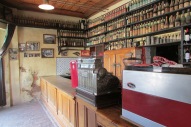Final Day in Argentina – A Letter
Today was our last day. We paid for a tour out of the city, booked through the hotel with ‘Signature Tours’ (www.signaturetours.com.ar) – it was brilliant. We wanted to see La pampas, the cattle rearing plains of Argentina. As it’s ‘low season’ it was just the two of us and a man in his car. He drove us out of the city, explaining things about the buildings as we passed them, so we started to understand a little more about Argentina. He then took us to a town and a ranch, introducing us to various people and showing us different places. It was all very friendly, it felt more like an acquaintance introducing us to his friends than a paid tour guide. It was also nice because, unlike on other tours we have done, we weren’t taken somewhere random (like a jade factory) and then left in awkward silence while the owner waits for us to buy something that we don’t really want. This guide didn’t even take us into the shop part of the places we visited, he wanted to show us things, not sell us things.
As we left Buenos Aires, we passed some poorer areas, they looked like the favelas we saw in Brazil, though maybe not quite as poor. Marcello told us that they were mostly occupied by immigrants from Peru, Paraguay, Chile. He said they work hard, often in construction, and are gradually moving to different areas. I asked if the homeless people that we saw on the streets were also immigrants, but he said that no, they were probably Argentinians. Economics are very hard here, due to the very high inflation. Everyone is hopeful that the newly elected government can turn things around in the next couple of years.
Marcello also told us about the gauchos that we’d be seeing. They are mainly men who work with cattle. They wear either hats (cowboy hats) or berets. The ranches, which are called “estancia” breed cattle, plus horses for working, polo and racing.
We went to the little town of San Antonio Areco. My favourite bit was the gaucho bars, I felt like I had walked into a cowboy film. The are still used today, though they’ve preserved the historical features. There was a post outside, for tying up the horses. Inside, the walls were shelved to the ceiling and full of ancient bottles of liquor, soap, shoes, tins of tea – all the things that the gauchos would have come into town to buy. The counter used to have bars all along it, with little windows for the drinks to be passed through, a bit like the railings or glass screens that you get in banks and post-offices today. This was to protect the staff and stock from the rowdy gauchos in an age when alcohol was more expensive. Is this where the term ‘bar’ originates from? (Tell me if you know!) The floors were tiled, there were ceiling fans and even an old fashioned til. You could so imagine a cowboy walking in and shooting all the bottles.
We also saw silver smiths at work. They make lots of horse related things – cups for polo matches, silver versions of the things that gauchos carry, horse ornaments. The gauchos carry knives (you can buy them in silver sheaves) and boleadoras. These were originally stones, wrapped in leather at the end of ropes. The gauchos would throw them, lasso style, at the legs of ostriches, to catch them. You can now buy silver versions, the stones in leather replaced with ornate silver balls. The work with silver was an incredibly slow, careful process. The designs were beautiful, real works of art. You would have to be both very artistic and very patient to do their job.
We saw a cheese and meat shop. The locals go there after work, for a platter of nibbles and a drink and chat (there were tables at the back.)
We saw a chocolate shop. They make the chocolate themselves from cacao, so we saw the beans and husks – which were much bigger than I expected, almost the size of coconuts. The bean is inside and they heat it first, to separate the cacao and the butter (which is white, but hard – more like chalk than butter.) They then add milk and sugar to make the chocolate. I would’ve liked to watch the process with the bean, but we weren’t taken to see that bit, we could only watch them work with the melted chocolate, through a glass panel.
 A traditional drink in Argentina, called ‘mate’ (pronounced ‘mah-tae’). The straws have a filter and people walk around drinking it. It’s a herb, like a bitter tea.
A traditional drink in Argentina, called ‘mate’ (pronounced ‘mah-tae’). The straws have a filter and people walk around drinking it. It’s a herb, like a bitter tea.
The silversmith’s work bench and the cheese shop
We then went to the ranch. This letter is getting a bit long, plus I want to tell you a little about the past in Argentina, the regimes and “The Disappeared”, so I’ll finish now and write again tomorrow.
Take care,
Anne x
Anne x
Thank you for reading.
If you enjoyed this, why not sign up to follow my blog?
anneethompson.com
xxxxxxxxxxxxxxxxxxxxxxxxxxxxxxxxxxxxxxxxxxxxxxxxxxxxx










